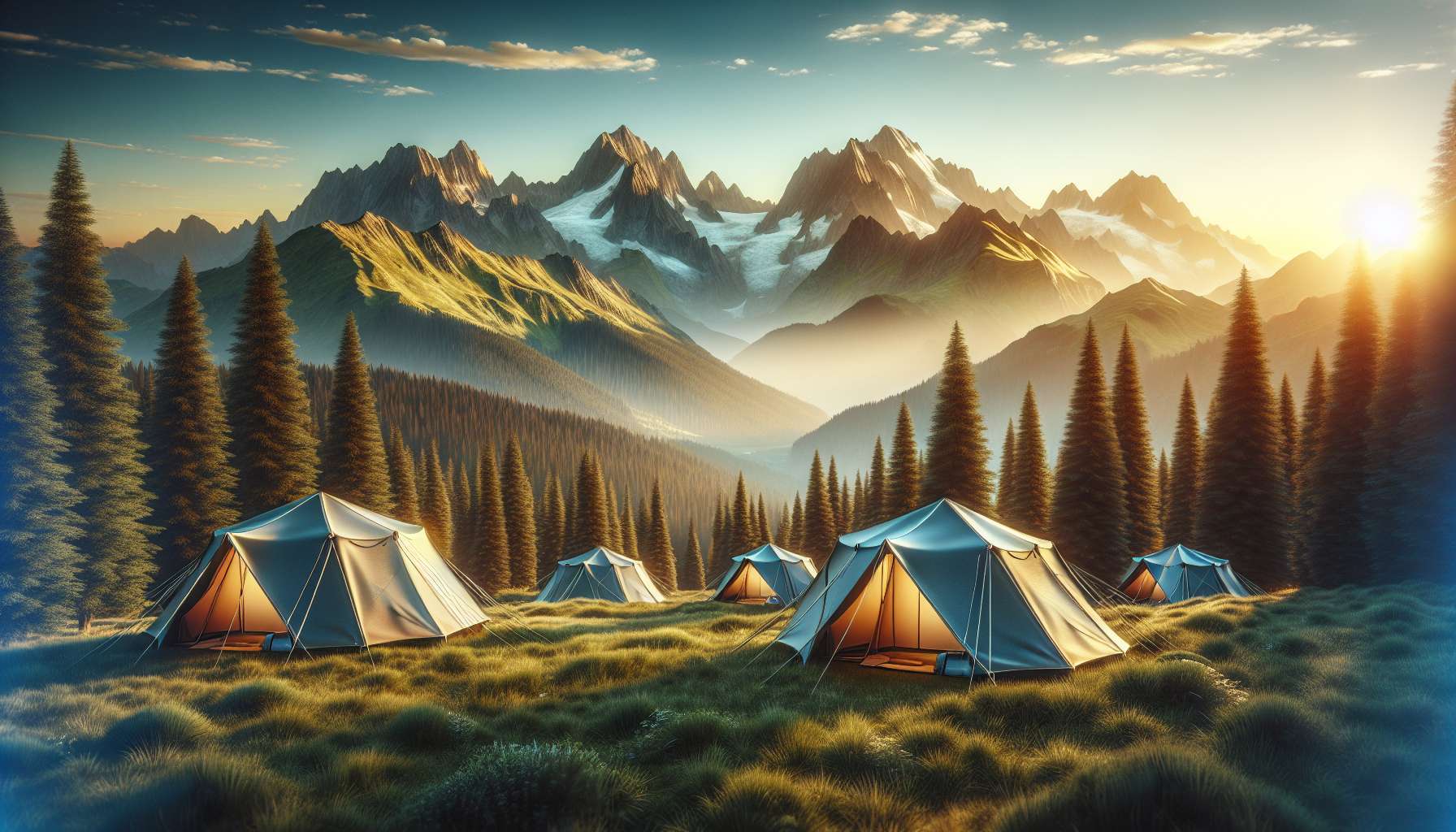The Complete Guide to Alpine Tents: Unveiling the Secrets of High-altitude Shelter
Imagine being surrounded by breathtaking snow-capped peaks, crisp mountain air filling your lungs, and a cozy shelter to call your own amidst the rugged wilderness. This is the allure of alpine tents, a vital companion for adventurers seeking refuge in the most challenging terrains. In this comprehensive guide, we will delve into the world of alpine tents, exploring their history, design, uses, and much more. Join us on this journey to unravel the secrets of high-altitude shelter.
The Evolution of Alpine Tents
Alpine tents have a rich history that dates back centuries, evolving from rudimentary shelters to sophisticated structures designed for extreme conditions. Historically, nomadic tribes and mountain dwellers crafted makeshift shelters using animal hides, branches, and rocks to protect themselves from the harsh elements of high-altitude environments. Over time, advancements in textile technology and design led to the development of lightweight, durable tents specifically tailored for alpine expeditions.
One of the earliest known references to alpine tents can be traced back to the Swiss Alps in the 19th century, where mountaineers used basic canvas tents to seek refuge during their ascents. As mountaineering gained popularity as a recreational activity, the demand for specialized alpine tents grew, leading to innovations in materials such as nylon, polyester, and Gore-Tex to enhance durability and weather resistance.
The Anatomy of an Alpine Tent
Alpine tents are meticulously engineered to withstand the harsh conditions of high-altitude environments, including strong winds, heavy snowfall, and extreme temperatures. The design of an alpine tent is characterized by several key features that differentiate it from traditional camping tents:
1. Geodesic or Dome Shape: The geodesic or dome shape of alpine tents helps distribute wind and snow loads evenly, preventing collapse under severe weather conditions. This design also enhances stability and structural integrity in challenging terrain.
2. Lightweight Materials: Alpine tents are typically constructed using lightweight, high-performance materials such as ripstop nylon, silnylon, or Dyneema composite fabrics. These materials offer a balance of durability and weight savings, crucial for alpine expeditions where every ounce matters.
3. Multiple Guy Lines and Anchor Points: Alpine tents feature multiple guy lines and anchor points to secure the tent firmly to the ground, preventing it from being blown away by strong winds. Reinforced seams and high-quality stakes further enhance the tent’s stability in adverse weather conditions.
4. Ventilation and Condensation Management: Proper ventilation is essential in alpine tents to prevent condensation buildup, which can lead to dampness and discomfort inside the tent. Mesh panels, vents, and breathable fabrics are incorporated to ensure adequate airflow while maintaining thermal efficiency.
5. Snow Skirts and Snow Flaps: Many alpine tents are equipped with snow skirts or snow flaps along the base to prevent snow from accumulating inside the tent. This feature helps maintain a dry and insulated interior, essential for surviving cold nights at high altitudes.
Applications of Alpine Tents
Alpine tents are versatile shelters that serve a wide range of purposes beyond mountaineering expeditions. Their lightweight, compact design makes them ideal for backpacking, camping, and outdoor adventures where space and weight are critical considerations. Additionally, alpine tents are commonly used in the following scenarios:
1. High-altitude Expeditions: Alpine tents are a lifeline for mountaineers and climbers tackling challenging peaks, providing a safe and secure base camp for acclimatization and rest. Their ability to withstand extreme weather conditions makes them indispensable in high-altitude environments.
2. Winter Camping: The robust construction and weather-resistant features of alpine tents make them well-suited for winter camping, where snow and freezing temperatures pose significant challenges. From backcountry skiing trips to cold-weather backpacking, alpine tents offer reliable protection against the elements.
3. Emergency Shelters: In emergency situations such as natural disasters or unexpected weather events, alpine tents can provide temporary shelter for individuals in need of protection. Their quick setup and durable construction make them valuable assets in crisis response efforts.
4. Research Expeditions: Scientists, researchers, and explorers conducting fieldwork in remote or extreme environments rely on alpine tents to create a safe and comfortable living space. These tents offer a mobile base for conducting experiments, studying wildlife, or monitoring environmental changes in challenging locales.
Choosing the Right Alpine Tent
When selecting an alpine tent for your outdoor adventures, several factors should be considered to ensure optimal performance and comfort. Here are some key considerations to keep in mind:
1. Capacity: Determine the number of occupants who will be using the tent to choose the appropriate size and configuration. Alpine tents are available in various capacities, from solo bivvy shelters to multi-person expedition tents.
2. Seasonality: Consider the seasons and conditions in which you will be using the tent. Some alpine tents are designed for four-season use, while others are more suitable for three-season camping. Choose a tent that matches the climate and terrain of your intended destination.
3. Weight and Packability: Since alpine tents are intended for use in remote and rugged environments, weight and packability are crucial factors to consider. Opt for a lightweight and compact tent that can be easily transported in a backpack or mountaineering pack.
4. Weather Resistance: Look for features that enhance the tent’s weather resistance, such as reinforced seams, waterproof coatings, and sturdy poles. A durable and windproof tent is essential for withstanding high winds, heavy snowfall, and inclement weather conditions.
5. Ventilation and Comfort: Ensure that the tent provides adequate ventilation to prevent condensation buildup and maintain a comfortable interior environment. Features such as mesh panels, adjustable vents, and vestibules can enhance airflow and livability inside the tent.
Expert Opinions on Alpine Tents
We reached out to seasoned mountaineers, outdoor enthusiasts, and gear experts to gather their insights on alpine tents and their importance in high-altitude expeditions. Here’s what they had to say:
“Alpine tents are a crucial piece of equipment for any serious mountaineer venturing into extreme environments. Their durability, weather resistance, and stability make them a reliable shelter option in the harshest conditions.” – Sarah, Experienced Climber
“Having the right alpine tent can make all the difference between a successful expedition and a miserable one. I always prioritize quality and performance when choosing a tent for my high-altitude adventures.” – Mark, Outdoor Enthusiast
Common Misconceptions about Alpine Tents
Despite their importance and versatility, alpine tents are sometimes subject to misconceptions and myths within the outdoor community. Let’s debunk some common misconceptions about alpine tents:
1. Myth: Alpine tents are only suitable for mountaineering expeditions. Reality: While alpine tents are commonly used in mountaineering, they are also valuable for a wide range of outdoor activities, including backpacking, camping, and emergency preparedness.
2. Myth: All alpine tents are heavy and bulky. Reality: Advances in materials and design have led to the development of lightweight and compact alpine tents that offer excellent performance without adding unnecessary weight to your pack.
Comparative Analysis of Popular Alpine Tents
There are numerous alpine tents available on the market, each offering unique features and capabilities to cater to different needs and preferences. Here’s a comparative analysis of popular alpine tents based on key criteria:
1. Brand: The North Face Assault 2 vs. Black Diamond Firstlight
2. Capacity: Mountain Hardwear Trango 2 vs. MSR Advance Pro 2
3. Weight: Hilleberg Nallo 2 vs. Big Agnes Tiger Wall UL2
4. Price: Rab Latok Mountain 2 vs. Nemo Chogori 2
Frequently Asked Questions about Alpine Tents
Q: Are alpine tents suitable for camping in all seasons? A: Alpine tents are designed to withstand harsh conditions, making them suitable for year-round use in varying climates.
Q: How do I properly maintain and care for my alpine tent? A: Regularly clean and dry your tent, store it in a cool, dry place, and avoid prolonged exposure to sunlight to prolong its lifespan.
To Wrap Things Up
Alpine tents represent the pinnacle of shelter design for high-altitude adventures, offering durability, weather resistance, and comfort in the most challenging environments. Whether you’re scaling a towering peak, exploring remote wilderness, or seeking refuge in a crisis, alpine tents are essential tools for outdoor enthusiasts and professionals alike. As you embark on your next alpine expedition, choose your tent wisely, embrace the elements, and savor the unparalleled beauty of the mountains from the safety of your alpine sanctuary.




